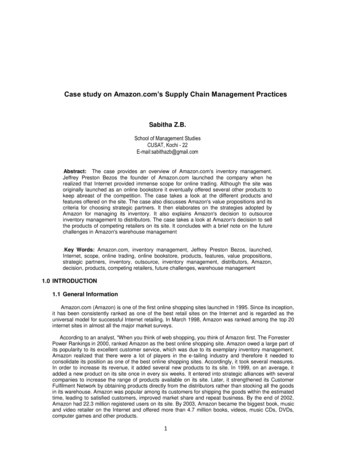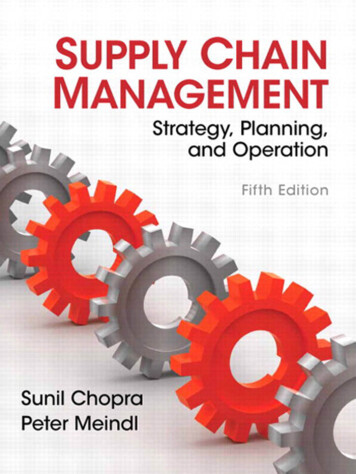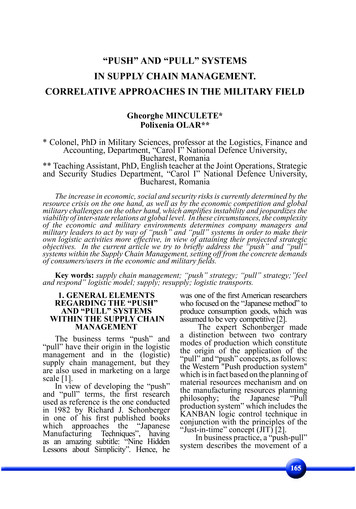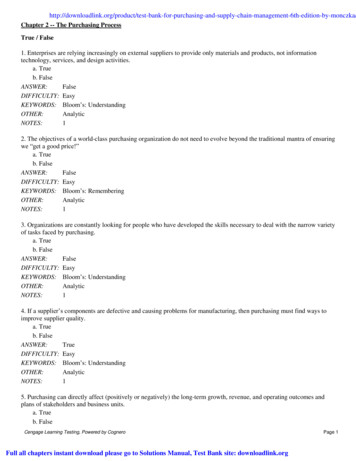
Transcription
International Journal of Business and Social ScienceVol. 2 No. 17www.ijbssnet.comA STUDY OF SUPPLY CHAIN MANAGEMENT PRACTICES: AN EMPIRICALINVESTIGATION ON CONSUMER GOODS INDUSTRY IN MALAYSIA.Dr.Inda SukatiProf. Dr. Abu Bakar Abdul HamidAssoc. Prof. Dr. Rohaizat BaharunDr. Huam Hon TatFaculty of Management and Human Resource DevelopmentUniversiti Teknologi MalaysiaE-mail: indasukati@utm.myFazila SaidMalaysia Nuclear AgencyMalaysiaABSTRACTThe purpose of this research is to present the relationship between supply chain management (SCM) practicesand supply chain responsiveness (SCR), and investigates its relationship with competitive advantage (CA). Thedata collection instrument used was a questionnaire which was administrated to a total sample of 200 managers.The response rate was 70% while 60% was usable questionnaires. Sample selection was based on conveniencesampling. The analyses involved statistical methods such as reliability and validity tests and multiple regressions.The results indicated that SCM practices are related to SCR. The result also suggested that SCR is related to CA.1. IntroductionIn today’s competitive business there is an increased focus on delivering value to the customer. The focus onattention of most of businesses is providing products and services that are more valuable compared to itscompetitors. Concurrent to the focus on customer value, the marketplace in which businesses operate today iswidely recognized as being complex and turbulent (Christopher, 2000; Goldman et al., 1995). The growth ofsupply chain aims to improve profitability, customer response and ability to deliver value to the customers andalso to improve the interconnection and interdependence among firms. Due to market expanding from domesticmarket to global market increase customer demands, for instance demanding lower prices, faster delivery, higherquality products or services and increase the variety of items (Braunscheidel, 2005). According to Towil andChristopher, (cited in Thatte, 2007), the end customer in the marketplace today determined by the success offailure of supply chains management practices. They stated that getting the right product, at the right price, at theright time to the customer is not only improved competitive success but also the key to survival.Many previous researches explored the importance of integrating suppliers, manufacturers, and customers orsupply chain integration (Frohlich and Westbrook, 2001; Clinton and Closs, 1997) (i.e. supply chainmanagement) so as to obtain flexibility and speed. By addressing supply chain management practices thatcontribute to supply chain responsiveness, will help the researcher better understand the scope and activitiesrelated to supply chain management that create enhanced level of supply chain responsiveness in competitivebusiness marketplace. The purpose of this study to find out the effect of supply chain management practices suchas strategic supplier partnership, customer relationship, information sharing and supply chain responsiveness. Thisstudy also investigates the effect of supply chain responsiveness in term of operation system responsiveness,logistic process responsiveness, supplier network responsiveness and competitive advantage of the firm. Thepaper is organized as follows. Relevant literature is reviewed and synthesized first to develop a conceptual model,followed by research methodology. The results are then presented along with discussion. Conclusion andimplication are discussed finally.2. Literature Review and HypothesesThe research objectives in this study were designed to investigate the effect of supply chain management practicesin terms of strategic supplier partnership, customer relationship, and information sharing on supply chainresponsiveness and to determine whether supply chain responsiveness has impact on competitive advantage of thefirm. Within these objectives, there are three concepts that needed to be explored, to obtain an understanding ofthese objectives. These concepts are reviewed both supplier and customer (externally) and internally.166
The Special Issue on Contemporary Issues in Business Studies Centre for Promoting Ideas, USAThese concepts are (1) supply chain management practices that encompasses supplier partnership, customerrelationship and information sharing, (2) supply chain responsiveness that includes operation systemresponsiveness, logistic process responsiveness, and supplier network responsiveness, (3) competitive advantageof the firm. Supply chain management practices as a multi-dimensional construct that encompasses upstream anddownstream sides of supply chain (Li et al, 2006). Donlon (1996) stated that outsourcing, supplier partnership,information sharing, cycle time, compression and continuous process flow, as a part of supply chain managementpractices. While Tan et al (1998) represented supply chain management practices in form of quality, purchasing,and customer relationship. Alvarado and Kotzab, in their empirical study focused on supply chain managementpractices on inter-organizational system used, core competences, and elimination of excess in inventory throughpostponement. The key aspect of supply chain management practices according to Tan et al (2002) were supplychain integration, information sharing, customer service management, geographic proximity, and JIT capabilities.Lee (2004) focused on five practices at supply chain level that are a key to create supply chain responsiveness.They includes outsourcing, strategic supplier partnerships, customer relationship, information sharing, andproduct modularity.Chen and Paulraj (2004) also conduct the research regarding supply chain management practices, theyinvestigated long-term relationship, cross-functional teams, supplier base reduction, and supplier involvement.The same with Chen and Paulraj, Min and Mentzer (2004) also examined in their study long-term relationship,information sharing, cooperation process integration and supply chain leadership underlying the supply chainmanagement practices. Lie et al (2005,2006); Thatte (2007) identified supply chain management practices in formof strategic supplier partnership, customer relationship, and information sharing. This research adopts the samesupply chain management practices (supplier partnership, customer relationship and information sharing).However, this study conducted in Malaysia perspective, especially in consumer goods industry. Li et al (2005);Thatte (2007) have developed a valid and reliable instrument to measure supply chain management practices. Thesimilar instrument also adopted in this research. The literature also depicts supply chain management practicesfrom different perspectives with goal of improving competitive advantage of firm. By improving competitiveadvantage of the firm, organization could improve its performance. Three dimensions of supply chainmanagement practices lead to supply chain responsiveness.These are strategic supplier partnership, customer relationship, and information sharing also identified. A supplychain is a network of organizations to perform a variety of processes and activities to generate value in the form ofproducts and services to end consumers. (Christopher, 1992). SCM involves an integrated and process-orientedapproach to the management, design and control of the supply chain, with the aim of producing value for the endconsumer, by both customer service and reduce cost (Bowersox and Closs, 1996; Giannoccaro and Pontrandolfo,2002). The supply chain management has dual purpose, in one side is to improve the performance of an individualorganization as well as that of the entire supply chain. In other side the supply chain management reducesorganization total cost (Li et al, 2006). Supply chain management (SCM) is the discipline which is relatively newand lack of theoretical conceptual framework of established or accepted methodology in general. Lambert, et al.,(1998) observed that "the term of SCM was originally introduced by consultants in the early 1980s. Since theearly 1990s, scholars have attempted to give structure to the development of SCM. Although the short story ofthis field, but the SCM literature has grown rapidly (Larson and Rogers, 1998). Shapiro (2001) showed that theSCM combining concepts from different disciplines such as strategic management and theory of the formation ofthe company; logistics, production and inventory management; accounting management; scientific forecastingand marketing, and operations research.Supply chain management (SCM) is one of business strategy increasingly being used in the business world todayand has become the focus of academic attention in recent years (Ballou, Gilbert & Mukherjee, 2000). Because theconcept of SCM is still in development, there are several theoretical frameworks and research methodologies needto be developed in the study of SCM (Tage, 1999). However, many articles have been published in variousdisciplines to try to define the SCM and discuss future directions and the corresponding empirical researchmethodology (Cooper, et al., 1997; Lambert & Cooper, 2000; Larson & Rogers, 1998; Tage, 1999).According to Lummus and Vokurka (1999) SCM as all activities involved in delivering products from rawmaterial to customer, including sources of raw material and parts, manufacturing and assembly, warehousing andinventory tracking, order entry and order management, distribution across all channels, delivery to customers andinformation systems required to monitor all activity.167
International Journal of Business and Social ScienceVol. 2 No. 17www.ijbssnet.comBowersox and Closs (1996) showed that to be fully effective in current’s competitive business, companies mustdevelop their integrated behavior to incorporated customers and suppliers. This expansion of integrated behaviors,through external integration, referred to by Bowersox and Closs (1996) as supply chain management. Thephilosophy of supply chain management turns into the implementation of SCM: a set of activities that carries outthe philosophy. The set of activities are coordinated effort called supply chain management between the supplychain partners, such as suppliers, manufactures and customers (Greene, 1991). Thatte (2007) stated that strategicsupplier partnership as the long-term relationship between the organization and its supplier. Gunasekaran et al(2001) asserted that a strategic partnership emphasizes long-term relationship between trading partners andpromote mutual planning an problem solving efforts. Strategic partnership between organizations promote sharedbenefits and ongoing collaboration in key strategic areas like technology, products, and market (Yoshino andRangan, 1995; Thatte, 2007). Strategic partnerships with suppliers lead organization working closely andeffectively with a few suppliers rather than many supplier that have been selected on the basis of cost efficient.Many advantage of consisting supplier early in the product-design process are that suppliers can offer costeffective design alternative, assist in selecting better components and technologies, and aid in designingassessment (Tan et al, 2002; Thatte, 2007).In supply chain management strategies, supplier relationship activities play an important role (Wisner, 2003).Long-term relationships refer to intention that the arrangement is not going to be temporary (Chen and Paulraj,2004). Through close relationship supply chain partners are willing to share risks and reward, and maintain therelationship on long term basis (Landeros and Monczka, 1989; Cooper and Ellram, 1993; Stuart, 1993; Thatte,2007). Toni and Nassimbeni (1999) identified that a long-term perspective between the buyer and supplierincrease the intensity of firm-supplier integration. Firms that integrate with customers including: planning,implementing, and evaluating a successful relationship between the provider and recipient of both upstream anddownstream of the supply chain. Therefore, customer relationship management (CRM) is not only focused oninbound customer relationships but also on outbound customer relationships in SCM. Customer relations relatedto the company's ability to communicate to the delivery of appropriate products and services to customers locallyand globally in the right time, right place, and appropriate of quantity and quality. Customer linkage especiallysharing product information with customers, receiving customer orders, interact with customers to managedemand, after placing the order system, share the status of orders with customers on scheduling orders, andproduct delivery stage (Lee, et al, 2007).A firm’s customer relationship practices can generate the organizational success in supply chain managementpractices efforts as well as its performance (Scott and Westbrook, 1991; Ellram, 1991; Turner, 1993). The successof supply chain management encompasses customer integration at the downstream and supplier integration at theupstream, considering that each entity in a supply chain is a supplier as well as a customer (Tan et al., 1999;Thatte, 2007). In the competitive business, better relationship management with customers is crucial fororganization success (Wines, 1996). Good relationship with business partners, including key customers areimportant role to success of supply chain management practiced by organization (Moberg et al, 2002; Tathee,2007). Customer relationship recognized as an internal component of an organization’s market strategy toincrease sales and profits (Bommer et, 2001; Thatte, 2007). Close customer relationship allow productdifferentiation from competitors, help sustain customer satisfaction and loyalty, and elevated the value provide tocustomer (Margaretta, 198; Thatte, 2007).Simatupang and Sridharan, (2002) defined information sharing as the access to private data between businesspartners thus enabling them to monitor the progress of products and orders as they pass thro
study also investigates the effect of supply chain responsiveness in term of operation system responsiveness, . Supply chain management (SCM) is one of business strategy increasingly being used in the business world today and has become the focus of academic attention in recent years (Ballou, Gilbert & Mukherjee, 2000). Because the concept of SCM is still in development, there are several .File Size: 266KBPage Count: 11











